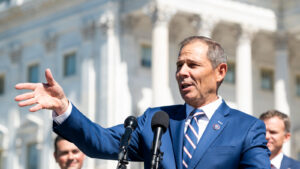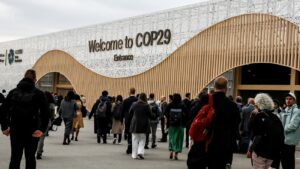
It took Samoan activist Tunaimati’a Jacob Netzler three flights and a bus ride over the course of 24 hours to reach the major climate conference. The plan was to join nearly 200 other campaigners from around 40 countries to discuss the fate of the planet.
But Netzler was not traveling to Baku, Azerbaijan, for COP29. Instead, he went to Oaxaca, Mexico, for the Global Meeting for Climate and Life that organizers called an “anti-COP.” The gathering would strike a decidedly different tone than its more formal United Nations counterpart. Luxury hotels and private jets gave way to dormitories and composting toilets that reflected the activists’ goal of creating a more egalitarian space.
“It really brought together people who normally wouldn’t be involved in the formal COP process,” said Netzler, the Pacific Campaign Associate for the Fossil Fuel Non-Proliferation Treaty Initiative. “It brought those in the frontline communities.”
Last week’s event was a byproduct of the sentiment that, after nearly 30 years, COPs are doing too little to address runaway greenhouse gas emissions. Even the former head of the United Nations Framework Convention on Climate Change, which governs the annual meeting, called the whirlwind events – which attract everyone from heads of state to oil industry lobbyists – “disturbing.”
Activists gathered in Oaxaca also agreed on a shared sense of exclusion from the international confederation, and concern that the solutions that emerge from it harm communities. Anti-COP aimed to “provide a space to articulate our struggle and propose concrete alternatives [to the status quo].” The five-day event concluded with a final statement which outlined the movement’s next steps — including plans for increased coordination among participants and a proposal to send caravans of activists to next year’s COP in Brazil.
One primary goal of the event was to promote understanding between climate and land defense movements that have historically worked in relatively separate spheres.
“There is a lot of reluctance from the indigenous groups to work with environmentalists because they are perceived as white movements, or movements that come from the global north,” explains Dianx Cantarey, the global coordinator for Climate Debt, one of the grassroots organizations that helped have to present the anti-COP.
In addition, the gathering tackled four main themes: The impact of clean energy megaprojects on the communities around them, the global water crisis, the ‘commodification of life’ and forced displacement of indigenous peoples. It also expressly denied what activists see as governmentlessness in the face of the climate crisis. Participants describe the gathering as both a response and an antidote to COP meetings, which they say often prioritize money, power and fossil fuel interests over human life – a point underlined by the fact that Elnur Soltanov, the head of this year’s event , was filmed using the summit making oil deals.
“When you sit in your tenth opening statement [at COP]and it’s all the same, it’s frustrating to think that no other world is possible,” says Xiye Bastida, the executive director of the Re-Earth Initiative, a youth-led nonprofit focused on making the climate movement more accessible and inclusive. to make She went to Oaxaca because “for us it’s not about the parts per million in the atmosphere, it’s about how our societies have transformed.”
Bastida, Netzler and others at the anti-COP feel marginalized by COP. She described cockroach-infested youth hotels at one year’s conference, and another attendee recalled being turned away from the indigenous pavilion once. It wasn’t always like that. At their inception in the 1980s and ’90s, climate negotiations were among the most welcoming and inclusive intergovernmental processes.
“Initially, the climate regime was extremely open, permeable and transparent,” said Dana Fisher, director of American University’s Center for Environment, Community and Equity, who did not attend the anti-COP. But, she said, that started to change around 2009, when the Dutch police clashed with, and arrested, hundreds of climate protesters at COP15 in Copenhagen. Since then, civil society has been increasingly sidelined; a phenomenon that has been particularly starkly displayed at the last three COPS, held in authoritarian states: Egypt, the United Arab Emirates, and now Azerbaijan.
“There has been a narrowing of the opportunity for NGO observers and members of civil society to participate,” Fisher said. “By the time we got to Egypt … they couldn’t go into the actual hall.”
As they were expressed, advocates lost confidence in COPs, creating what Fisher calls an “interaction effect” that led to the depth of distrust that gave rise to initiatives such as anti-COP. Although it was the band’s second gathering, this year’s was much bigger and the first to lay out a road map for future performances.
Anti-COP participants called for everything from mapping the financial interests behind clean energy megaprojects that impact indigenous communities to building a database of best, successful land defense practices and denounce the election of Donald Trump. There were also more blunt statements, including a declaration that “All COPs are Bastards!”
Still, the anti-COP was held a week before the formal COP for a reason: Some of those who gathered in Oaxaca planned to be in Baku.
“For me, the scope of COP is to read negotiation texts and make sure that they include and defend as many people as possible,” Bastida said, admitting that it will probably be an exhausting experience. But, she added, “If I didn’t go to anti-COP, I couldn’t go to a COP knowing that I was doing my part to include voices that were missing.”




